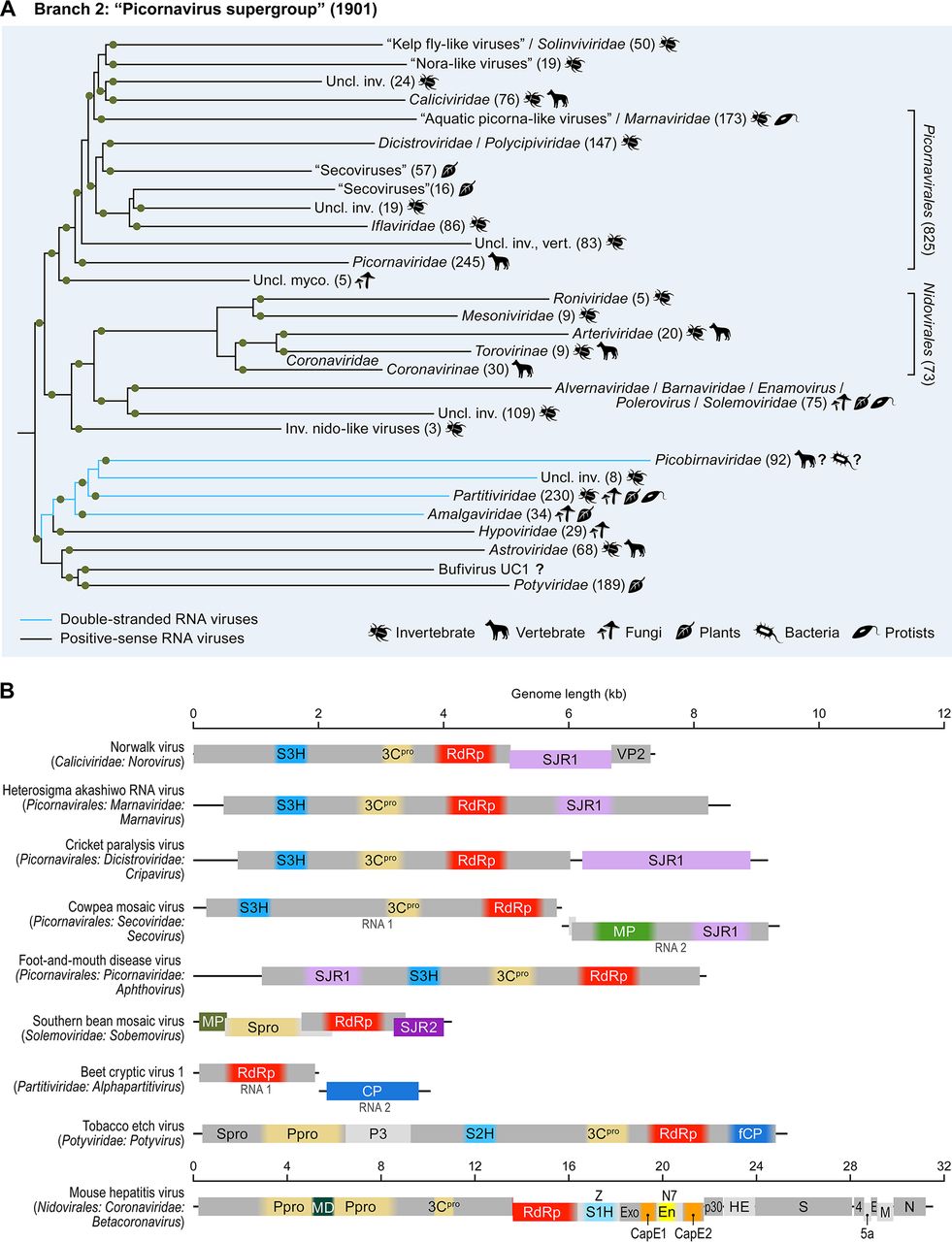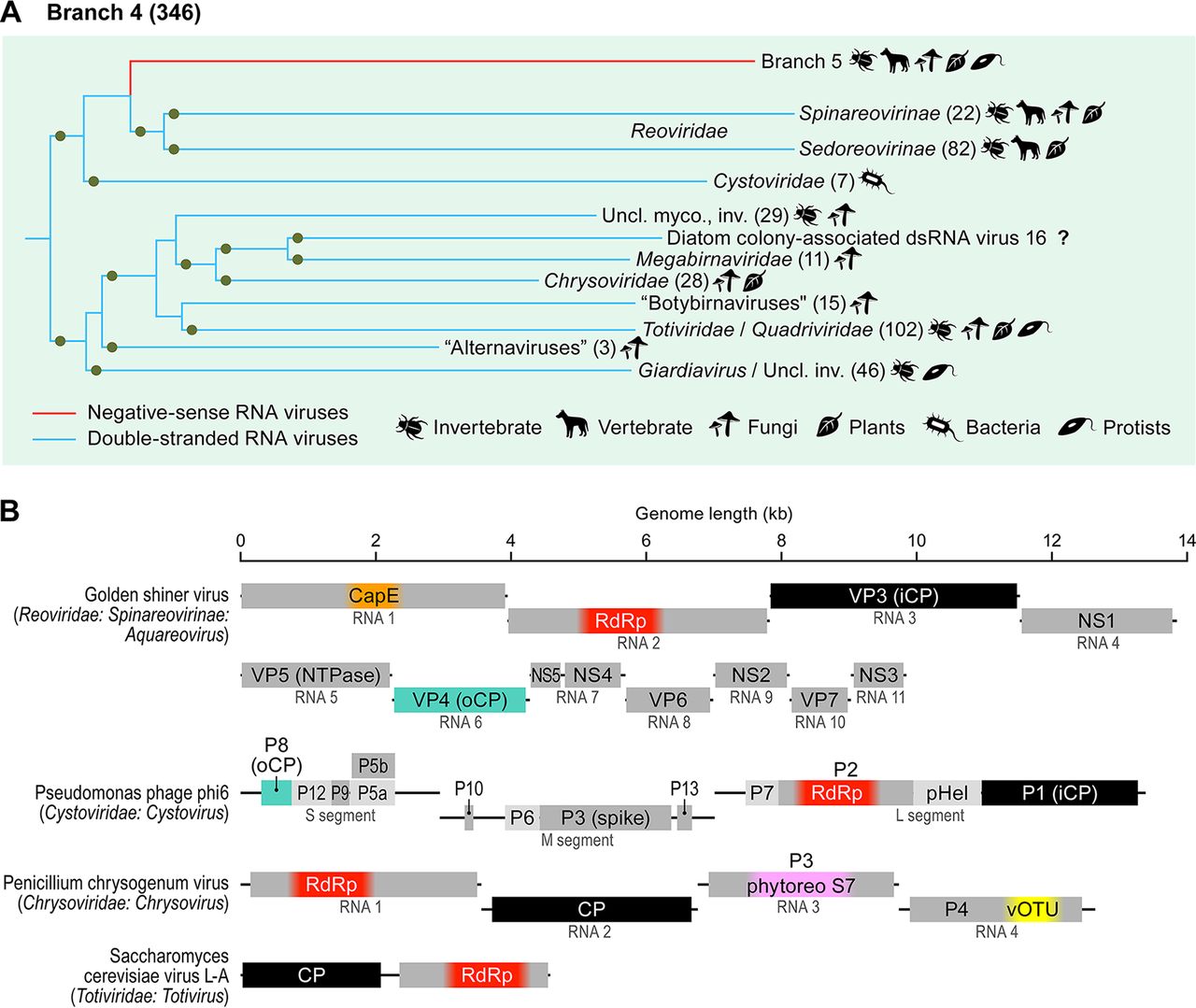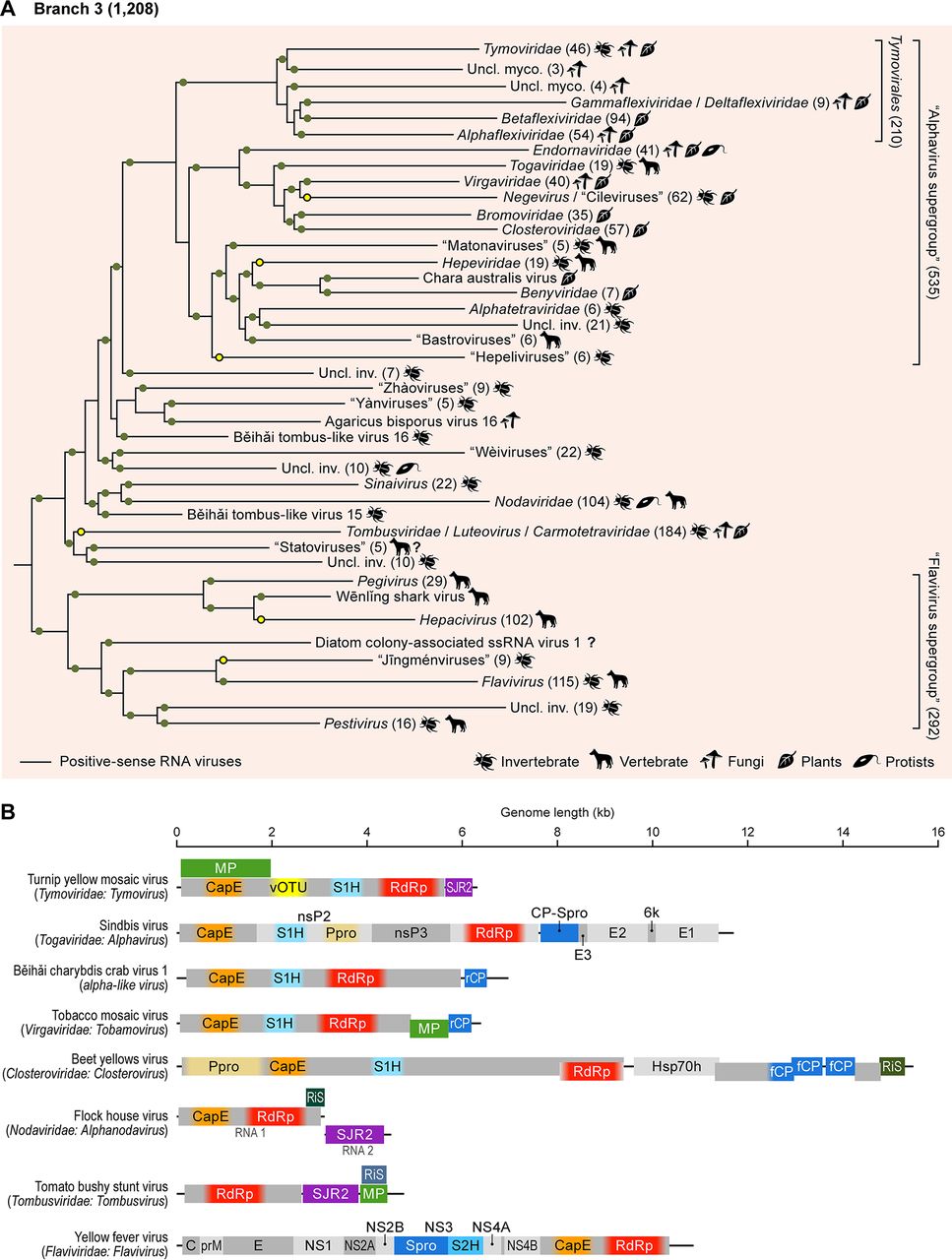|
Pisuviricota
''Pisuviricota'' is a phylum of RNA viruses that includes all positive-strand and double-stranded RNA viruses that infect eukaryotes and are not members of the phylum ''Kitrinoviricota,'' ''Lenarviricota'' or ''Duplornaviricota.'' The name of the group is a syllabic abbreviation of “''pi''cornavirus ''su''pergroup” with the suffix ''-viricota'', indicating a virus phylum. Phylogenetic analyses suggest that ''Birnaviridae'' and ''Permutotetraviridae'', both currently unassigned to a phylum in ''Orthornavirae'', also belong to this phylum and that both are sister groups. Another proposed family of the phylum is unassigned '' Polymycoviridae'' in ''Riboviria''.Suvi Sutela, Anna Poimala, Eeva J Vainio (2019)Viruses of fungi and oomycetes in the soil environment Oxford Academic. Classes The following classes are recognized: * ''Duplopiviricetes'' * ''Pisoniviricetes'' * ''Stelpaviricetes ''Stelpaviricetes'' is a class of non-enveloped, positive-strand RNA viruses which i ... [...More Info...] [...Related Items...] OR: [Wikipedia] [Google] [Baidu] |
Positive-strand RNA Virus
Positive-strand RNA viruses (+ssRNA viruses) are a group of related viruses that have positive-sense, single-stranded genomes made of ribonucleic acid. The positive-sense genome can act as messenger RNA (mRNA) and can be directly translated into viral proteins by the host cell's ribosomes. Positive-strand RNA viruses encode an RNA-dependent RNA polymerase (RdRp) which is used during replication of the genome to synthesize a negative-sense antigenome that is then used as a template to create a new positive-sense viral genome. Positive-strand RNA viruses are divided between the phyla ''Kitrinoviricota'', ''Lenarviricota'', and ''Pisuviricota'' (specifically classes ''Pisoniviricetes'' and '' Stelpavirictes'') all of which are in the kingdom '' Orthornavirae'' and realm '' Riboviria''. They are monophyletic and descended from a common RNA virus ancestor. In the Baltimore classification system, +ssRNA viruses belong to Group IV. Positive-sense RNA viruses include pathogen ... [...More Info...] [...Related Items...] OR: [Wikipedia] [Google] [Baidu] |
Orthornavirae
''Orthornavirae'' is a kingdom of viruses that have genomes made of ribonucleic acid (RNA), those genomes encoding an RNA-dependent RNA polymerase (RdRp). The RdRp is used to transcribe the viral RNA genome into messenger RNA (mRNA) and to replicate the genome. Viruses in this kingdom also share a number of characteristics involving evolution, including high rates of genetic mutations, recombinations, and reassortments. Viruses in ''Orthornavirae'' belong to the realm ''Riboviria''. They are descended from a common ancestor that may have been a non-viral molecule that encoded a reverse transcriptase instead of an RdRp for replication. The kingdom is subdivided into five phyla that separate member viruses based on their genome type, host range, and genetic similarity. Viruses with three genome types are included: positive-strand RNA viruses, negative-strand RNA viruses, and double-stranded RNA viruses. Many of the most widely known viral diseases are caused by RNA viruses in the ... [...More Info...] [...Related Items...] OR: [Wikipedia] [Google] [Baidu] |
Double-stranded RNA Viruses
Double-stranded RNA viruses (dsRNA viruses) are a polyphyletic group of viruses that have double-stranded genomes made of ribonucleic acid. The double-stranded genome is used to transcribe a positive-strand RNA by the viral RNA-dependent RNA polymerase (RdRp). The positive-strand RNA may be used as messenger RNA (mRNA) which can be translated into viral proteins by the host cell's ribosomes. The positive-strand RNA can also be replicated by the RdRp to create a new double-stranded viral genome. Double-stranded RNA viruses are classified in two separate phyla ''Duplornaviricota'' and ''Pisuviricota'' (specifically class ''Duplopiviricetes''), which are in the kingdom ''Orthornavirae'' and realm ''Riboviria''. The two groups do not share a common dsRNA virus ancestor. Double-stranded RNA viruses evolved two separate times from positive-strand RNA viruses. In the Baltimore classification system, dsRNA viruses belong to Group III. Virus group members vary widely in host range (anim ... [...More Info...] [...Related Items...] OR: [Wikipedia] [Google] [Baidu] |
Duplornaviricota
''Duplornaviricota'' is a phylum of RNA viruses, which contains all double-stranded RNA viruses, except for those in phylum ''Pisuviricota.'' Characteristic of the group is a viral capsid composed of 60 homo- or heterodimers of capsid protein on a pseudo-T=2 lattice. Duplornaviruses infect both prokaryotes and eukaryotes. The name of the group derives from Italian ''duplo'' which means double (a reference to double-stranded), ''rna'' for the type of virus, and -''viricota'' which is the suffix for a virus phylum. Classes The following classes are recognized: * ''Chrymotiviricetes'' * ''Resentoviricetes'' * ''Vidaverviricetes ''Cystovirus'' is a genus of double-stranded RNA viruses which infects bacteria. It is the only genus in the family ''Cystoviridae.'' The name of the group c''ysto'' derives from Greek ''kystis'' which means bladder or sack. There are seven spec ...'' References Viruses {{Virus-stub ... [...More Info...] [...Related Items...] OR: [Wikipedia] [Google] [Baidu] |
Kitrinoviricota
''Kitrinoviricota'' is a phylum of RNA viruses that includes all positive-strand RNA viruses that infect eukaryotes and are not members of the phylum ''Pisuviricota'' or ''Lenarviricota.'' The name of the group derives from Greek ''κίτρινος'' (''kítrinos''), which means yellow (a reference to yellow fever virus), and -''viricota'', which is the suffix for a virus phylum. Classes The following classes are recognized: * ''Alsuviricetes'' * ''Flasuviricetes'' * ''Magsaviricetes'' * ''Tolucaviricetes ''Tolivirales'' is an order of RNA viruses which infect insects and plants. Member viruses have a positive-sense single-stranded RNA genome. The virions are non-enveloped, spherical, and have an icosahedral capsid. The name of the group is a ...'' References Viruses {{Virus-stub ... [...More Info...] [...Related Items...] OR: [Wikipedia] [Google] [Baidu] |
Transmission Electron Microscopy
Transmission electron microscopy (TEM) is a microscopy technique in which a beam of electrons is transmitted through a specimen to form an image. The specimen is most often an ultrathin section less than 100 nm thick or a suspension on a grid. An image is formed from the interaction of the electrons with the sample as the beam is transmitted through the specimen. The image is then magnified and focused onto an imaging device, such as a fluorescent screen, a layer of photographic film, or a sensor such as a scintillator attached to a charge-coupled device. Transmission electron microscopes are capable of imaging at a significantly higher resolution than light microscopes, owing to the smaller de Broglie wavelength of electrons. This enables the instrument to capture fine detail—even as small as a single column of atoms, which is thousands of times smaller than a resolvable object seen in a light microscope. Transmission electron microscopy is a major analytical method i ... [...More Info...] [...Related Items...] OR: [Wikipedia] [Google] [Baidu] |
Pisoniviricetes
''Pisoniviricetes'' is a class of positive-strand RNA viruses which infect eukaryotes. A characteristic of the group is a conserved 3C- like protease from the PA clan of proteases for processing the translated polyprotein. The name of the group is a portmanteau of member orders "''pi''cornavirales, ''so''belivirales, ''ni''dovirales" and -''viricetes'' which is the suffix for a virus class. Orders The following orders are recognized: * ''Nidovirales'' * ''Picornavirales'' * ''Sobelivirales ''Sobelivirales'' is an order of RNA virus, RNA viruses which infect Eukaryote, eukaryotes. Member Virus, viruses have a Positive-sense single-stranded RNA virus, positive-sense single-stranded RNA genome. The name of the group is a portmanteau o ...'' References Viruses {{Virus-stub ... [...More Info...] [...Related Items...] OR: [Wikipedia] [Google] [Baidu] |
Duplopiviricetes
''Durnavirales'' is an order of double-stranded RNA viruses which infect eukaryotes. The name of the group derives from Italian ''duplo'' which means double (a reference to double-stranded), ''rna'' for the type of virus, and -''virales'' which is the suffix for a virus order. Families The following families are recognized: * '' Amalgaviridae'' * '' Curvulaviridae'' * ''Hypoviridae'' * ''Partitiviridae ''Partitiviridae'' is a family of double-stranded RNA viruses. Plants, fungi, and protozoa serve as natural hosts. It has been suggested that they can also infect bacteria. The name comes from the Latin ''partitius,'' which means divided, and ...'' * '' Picobirnaviridae'' References Viruses {{Virus-stub ... [...More Info...] [...Related Items...] OR: [Wikipedia] [Google] [Baidu] |
MBio
''mBio'' is a bimonthly peer-reviewed open access scientific journal published by the American Society for Microbiology in association with the American Academy of Microbiology. It covers all aspects of the microbiological sciences, including virology, bacteriology, parasitology, mycology, and allied fields. The journal was established in 2010 with Arturo Casadevall as founding editor-in-chief. Abstracting and indexing The journal is abstracted and indexed in: According to the ''Journal Citation Reports'', the journal has a 2019 impact factor The impact factor (IF) or journal impact factor (JIF) of an academic journal is a scientometric index calculated by Clarivate that reflects the yearly mean number of citations of articles published in the last two years in a given journal, as i ... of 6.784. References External links * {{DEFAULTSORT:Mbio Microbiology journals Publications established in 2010 Bimonthly journals English-language journals American Society for Micr ... [...More Info...] [...Related Items...] OR: [Wikipedia] [Google] [Baidu] |
Permutotetraviridae
''Permutotetraviridae'' is a family of viruses A virus is a submicroscopic infectious agent that replicates only inside the living cells of an organism. Viruses infect all life forms, from animals and plants to microorganisms, including bacteria and archaea. Since Dmitri Ivanovsky's 1 .... Lepidopteran insects serve as natural hosts. The family contains one genus that has two species. Diseases associated with this family include: infection outcome varies from unapparent to lethal. Taxonomy ''Permutotetraviridae'' has one genus which contains two species: * Genus: ''Alphapermutotetravirus'' ** '' Euprosterna elaeasa virus'' ** '' Thosea asigna virus'' Structure Viruses in ''Permutotetraviridae'' are non-enveloped, with icosahedral geometries, and T=4 symmetry. The diameter is around 40 nm. Genomes are linear, around 5.6kb in length. Life cycle Viral replication is cytoplasmic. Entry into the host cell is achieved by penetration into the host cell. Replication ... [...More Info...] [...Related Items...] OR: [Wikipedia] [Google] [Baidu] |
Birnaviridae
''Birnaviridae'' is a family of double-stranded RNA viruses. Salmonid fish, birds and insects serve as natural hosts. There are currently 11 species in this family, divided among seven genera. Diseases associated with this family include infectious pancreatic necrosis in salmonid fish, which causes significant losses to the aquaculture industry, with chronic infection in adult salmonid fish and acute viral disease in young salmonid fish. Structure Viruses in family ''Birnaviridae'' are non-enveloped, with icosahedral single-shelled geometries, and T=13 symmetry. The diameter is around 70 nm. Genome The genome is composed of linear, bi-segmented, double-stranded RNA. It is around 5.9–6.9 kbp in length and codes for five to six proteins. Birnaviruses encode the following proteins: RNA-directed RNA polymerase (VP1), which lacks the highly conserved Gly-Asp-Asp (GDD) sequence, a component of the proposed catalytic site of this enzyme family that exists in the conserve ... [...More Info...] [...Related Items...] OR: [Wikipedia] [Google] [Baidu] |






.png)